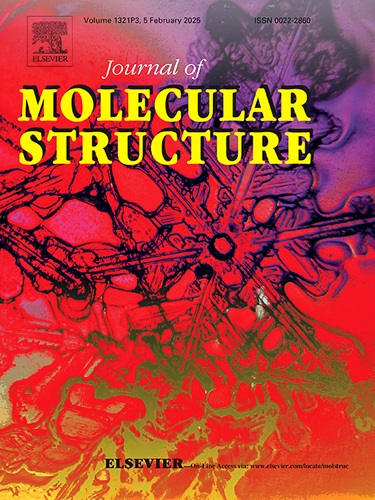Microwave synthesis, X-ray analysis, in vitro and in silico evaluation of the antioxidant and anti-urease activities of novel acridines derived from β-enaminones
IF 4
2区 化学
Q2 CHEMISTRY, PHYSICAL
引用次数: 0
Abstract
A series of 14 acridine derivatives was synthesized from the condensation of different β-enaminones and aromatic aldehydes, under microwave irradiation in catalyst-free conditions. The synthesis was favored for its rapidity, good yields, and environmental friendliness as it avoided the use of dangerous products and involved the employment of simple reactants and benign reaction conditions. The introduction of an ortho substituent in the aromatic aldehyde ring led to novel acridine-derived molecules containing hydroxyl groups. The structure of imino-acridine 5d was fully determined using XRD method and confirmed the obtainment of both E-(R) and E-(S) isomers. In vitro studies were performed to evaluate the antioxidant capacity of the synthesized compounds as well as the anti-urease activity. The results showed that the novel hydroxylated compound 5m was potent in the DPPH antioxidant test (IC50 = 0.99 ± ¦0.13 µmol/mL) and gave an interesting activity against urease enzyme with an IC50 of 0.03 ± ¦0.01 µmol/mL that is considered better than the standard molecule thiourea (IC50 = 0.10 ± ¦0.004 µmol/mL). An in silico investigation that consisted of a molecular docking study and molecular dynamics simulation was completed to predict the binding mode of the novel hydroxylated compound 5m towards active sites of both xanthine oxidase and urease enzymes as antioxidant and anti-urease targets, respectively. Furthermore, we employed DFT calculations to analyze the electronic and geometric properties of the optimal compound, 5m The HOMO and LUMO band gap energies, as well as the molecular electrostatic potential surface, were deduced for the stable structure.

求助全文
约1分钟内获得全文
求助全文
来源期刊

Journal of Molecular Structure
化学-物理化学
CiteScore
7.10
自引率
15.80%
发文量
2384
审稿时长
45 days
期刊介绍:
The Journal of Molecular Structure is dedicated to the publication of full-length articles and review papers, providing important new structural information on all types of chemical species including:
• Stable and unstable molecules in all types of environments (vapour, molecular beam, liquid, solution, liquid crystal, solid state, matrix-isolated, surface-absorbed etc.)
• Chemical intermediates
• Molecules in excited states
• Biological molecules
• Polymers.
The methods used may include any combination of spectroscopic and non-spectroscopic techniques, for example:
• Infrared spectroscopy (mid, far, near)
• Raman spectroscopy and non-linear Raman methods (CARS, etc.)
• Electronic absorption spectroscopy
• Optical rotatory dispersion and circular dichroism
• Fluorescence and phosphorescence techniques
• Electron spectroscopies (PES, XPS), EXAFS, etc.
• Microwave spectroscopy
• Electron diffraction
• NMR and ESR spectroscopies
• Mössbauer spectroscopy
• X-ray crystallography
• Charge Density Analyses
• Computational Studies (supplementing experimental methods)
We encourage publications combining theoretical and experimental approaches. The structural insights gained by the studies should be correlated with the properties, activity and/ or reactivity of the molecule under investigation and the relevance of this molecule and its implications should be discussed.
 求助内容:
求助内容: 应助结果提醒方式:
应助结果提醒方式:


